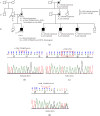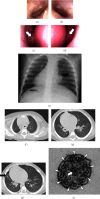Two Pediatric Cases of Primary Ciliary Dyskinesia Caused by Loss-of-Function Variants in Oral-Facial-Digital Syndrome Gene, OFD1
- PMID: 39156004
- PMCID: PMC11329306
- DOI: 10.1155/2024/1595717
Two Pediatric Cases of Primary Ciliary Dyskinesia Caused by Loss-of-Function Variants in Oral-Facial-Digital Syndrome Gene, OFD1
Abstract
Primary ciliary dyskinesia (PCD) is a hereditary disease caused by genes related to motile cilia. We report two male pediatric cases of PCD caused by hemizygous pathogenic variants in the OFD1 centriole and centriolar satellite protein (OFD1) gene. The variants were NM_003611.3: c.[2789_2793delTAAAA] (p.[Ile930LysfsTer8]) in Case 1 and c.[2632_2635delGAAG] (p.[Glu878LysfsTer9]) in Case 2. Both cases had characteristic recurrent respiratory infections. Neither case had symptoms of oral-facial-digital syndrome type I. We identified a variant (c.2632_2635delGAAG) that has not been previously reported in any case of OFD1-PCD.
Copyright © 2024 Yifei Xu et al.
Conflict of interest statement
The authors declare that they have no conflicts of interest.
Figures




References
-
- Zariwala M. A., Knowles M. R., Leigh M. W. Primary Ciliary Dyskinesia . Seattle, WA, USA: University of Washington Press; 2007. - PubMed
Publication types
LinkOut - more resources
Full Text Sources

